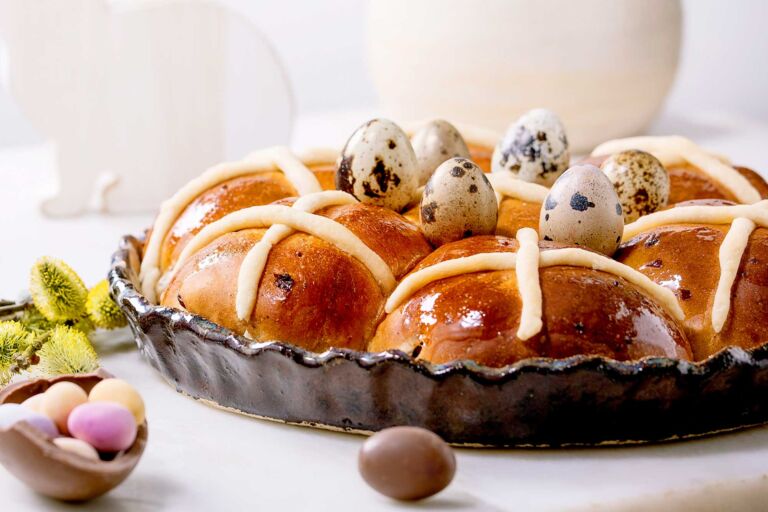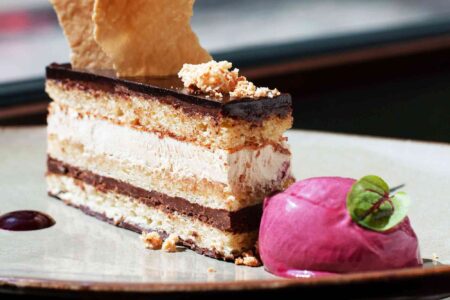Hot Cross Buns Recipe
Lightly toast them and serve hot, slathered with the awesome Irish butter.
It is the perfect Easter bun!
There’s even a schoolyard rhyme about Hot Cross Buns, which is sung while clapping in time with the rhythm of the words.
For generations, this has been a childhood favourite.
And it goes something like this:
Hot Cross Buns, Hot Cross Buns, One ha’penny, Two ha’penny, Hot Cross Buns!
If you have no daughters, Give them to your sons,
One ha’penny, Two ha’penny, Hot Cross Buns.

Hot Cross Buns Recipe
| Prep time | Cook Time | Rest Time | Total Time |
|---|---|---|---|
| 30 min | 20 min | 180 min | 230 min |
On Good Friday, What Else Than Hot Cross Buns?
Hot Cross Buns are eaten every Good Friday in Christian communities throughout Ireland, the United Kingdom, and as far away as New Zealand, Australia, Canada, and India and some parts of the Americas, including the United States.
They are symbolic of this pivotal day in Christian history, when Jesus was crucified. Each bun is decorated with a flour paste cross that represents the cross on which Christ died.
Hot cross bun spices are said to represent the spices used to embalm Christ after his death.

A Little History
Hot Cross Buns are inextricably linked to Easter and to Christianity. However, they are most likely pre-Christian in origin. ‘Cross Buns’ were baked to honor Eostre, a Germanic Goddess of Fertility, after whom the Easter season is said to have been named.
Plain buns are made without dairy products in many historically Christian countries. In the sixth century AD, the Greeks may have marked cakes with a cross.
According to one theory, the hot cross bun originated in St. Albans, England in 1361, when Brother Thomas Rodcliffe, a 14th-century monk at St Albans Abbey, developed a similar recipe known as a ‘Alban Bun’ and distributed it to the local poor on Good Friday.
During Elizabeth I of England’s reign, the London Clerk of Markets issued a decree prohibiting the sale of hot cross buns and other spiced breads except at burials, Good Friday, and Christmas.
The penalty for violating the decree was the forfeiture of all forbidden goods to the poor.

As a result of this decree, hot cross buns were primarily made in domestic kitchens at the time. Attempts to prohibit the sale of these items were made again during the reign of James I of England (1603–1625).
A London street cry provides the first definite record of hot cross buns: “Good Friday comes this month, the old woman runs. With one or two a penny hot cross buns”, which was published in Poor Robin’s Almanac in 1733.
The phrase “one a penny, two a penny, hot cross-buns” appears in the English nursery rhyme “Hot Cross Buns,” which was published in the London Chronicle on June 2–4, 1767.
According to food historian Ivan Day, “The buns were made in London during the 18th century. But when you start looking for records or recipes earlier than that, you hit nothing.”
Ingredients
For the buns
For the cross
For the glaze
Instructions
Bring 300 ml whole milk to a boil, then remove from heat and stir in the butter.
Allow to cool until it is hand temperature.
In a mixing bowl, combine the bread flour, 1 teaspoon salt, sugar, and yeast.
Create a well in the center. Pour in the warm milk-butter mixture, followed by 1 beaten egg.Mix well with a wooden spoon, then bring everything together with your hands until you have a sticky dough.
Place the dough on a lightly floured surface and knead it by holding it in one hand and stretching it with the heal of the other, then folding it back on itself.
Repeat for 5 minutes, or until became smooth and elastic. Place the dough in a lightly oiled mixing bowl.
Cover with oiled cling film and set aside for 1 hour to raise, or until doubled in size and a finger pressed into it leaves a dent.While the dough is still in the bowl, add the raisins, the mixed peel, one orange zest, one peeled, cored and finely chopped apple, and the cinnamon.
Knead the dough to ensure that everything is evenly distributed.
Allow to rise for 1 hour more, or until doubled in size, covered with well-oiled cling film to prevent the dough from crusting.
Cut the dough into 15 equal pieces.
On a lightly floured work surface, roll each piece into a smooth ball.Arrange the buns on one or two baking trays lined with parchment paper, leaving room for the dough to expand.
Cover with a clean tea towel and set aside for another 1 hour to prove.Preheat the oven to 220°C (428°F).
Make the cross for the bun now.
To make the cross paste, combine the flour with about 5 tablespoons water – add the water one tablespoon at a time, until you have a thick paste.
Fill a piping bag fitted with a small nozzle with the mixture.
Pipe a line down the center of each row of buns, then repeat in the opposite direction to make crosses.Bake for 20 minutes on the middle oven shelf, or until golden brown.
Gently warm on low heat the apricot jam, until melted, then sieve to remove any chunks.
Brush the warm jam over the tops of the warm buns and set aside to cool.
Enjoy, Good Appetite!











